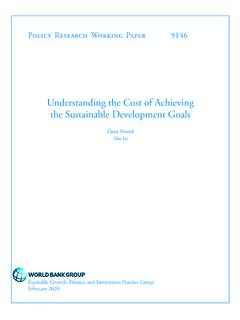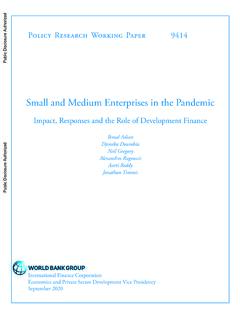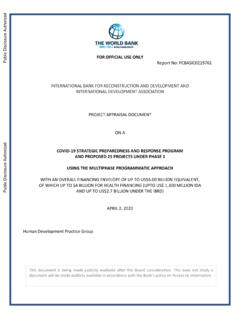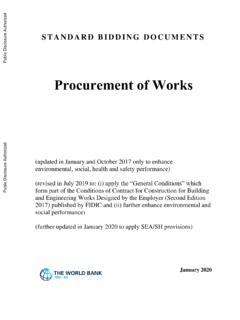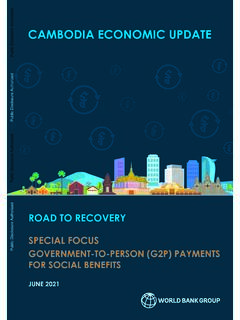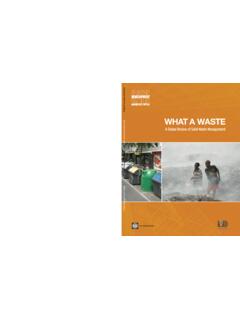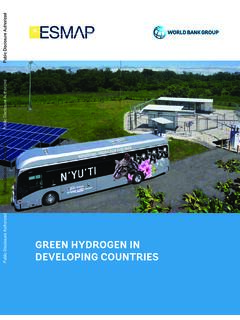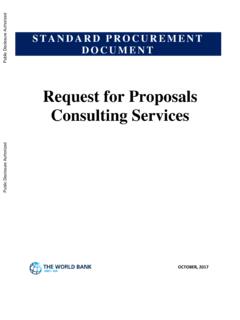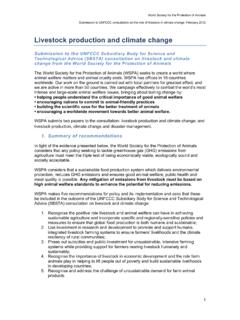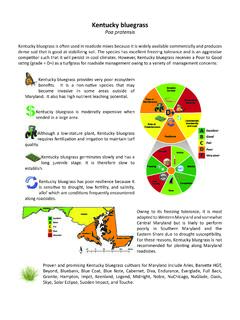Transcription of Ethiopia’s Productive Safety Net Program (PSNP ...
1 Public Disclosure Authorized 80622. Ethiopia's Productive Safety Net Program (PSNP). Integrating Disaster And Public Disclosure Authorized Climate Risk Management Public Disclosure Authorized CASE STUDY. June 2013. Public Disclosure Authorized ETHIOPIA'S Productive Safety NET Program (PSNP). INTEGRATING DISASTER AND CLIMATE RISK MANAGEMENT. summary Ethiopia's Productive Safety Net Program (PSNP) is a large national social Safety net (SSN). Program that responds not only to chronic food insecurity among Ethiopia's poor, but also to shorter-term shocks, mainly droughts. It targets a highly climate-vulnerable population, offering a practical model of how SSNs can be designed to meet the social protection needs of the most vulnerable, while simultaneously reducing the risks from disaster and climate-related impacts. The PSNP incorporates a number of interesting features, such as: public works activities geared towards improving climate resiliency; a risk financing facility to help poor households and communities to better cope with transitory shocks, including households outside of the core Program ; and the use of targeting methods that assist the most climate-vulnerable community members to obtain the full benefits of consumption smoothing and asset protection.
2 The Program also works through, and focuses on strengthening, existing government institutional systems at all levels rather than creating separate systems. The combination of a secure and regular/predictable entitlement of poor households to a government transfer, protection of poor households against natural hazard shock impacts and significant improvements in the management of the natural environment that contributes to these risks has enabled the Program 's core beneficiaries to meet consumption needs, mitigate risks and avoid selling Productive assets during times of crisis ( , droughts). There is evidence that livelihoods are stabilizing and food insecurity is being reduced among these households. Natural Disaster/Climate Change Context With 80 percent of its population dependent on rain-fed agriculture, Ethiopia is particularly vulnerable to weather-related shocks. Rain varies greatly by region and is particularly unpredictable (World Bank/United Nations, 2010).
3 Although the Intergovernmental Panel on Climate Change (IPCC) predicts only a modest change in Ethiopia's rainfall patterns in future (Christensen et al, 2007), this can still adversely affect very poor small farmers especially if such decreases are concentrated in the growing season (Oxfam International, 2010). Over the past six decades, Ethiopia has been particularly susceptible to drought, with a drought occurring every three to five years. Serious droughts and often famine, either widespread or localized, have occurred several times and affected millions of people. Environmental degradation and poor natural resource management together with a reduction in size of average landholdings due to high population growth and, conflict, governance and institutional capacity issues have exacerbated the impacts of these droughts. All of these factors have contributed to the erosion of the Productive assets and coping capacities of households and communities.
4 Food insecurity is widespread and food aid needs have been sizable, fluctuating between - percent of GDP between 1996 and 2001 (World Bank/United Nations, 2010). 1. Overview of PSNP. The Government of Ethiopia (GoE), in partnership with international organizations, aid donors, and civil society, decided to supplement the existing reactive emergency food aid system with a longer-term solution for reducing vulnerability to food insecurity, called the National Food Security Programme (FSP). The Productive Safety Nets Program (PSNP) is a core element of the broader Program . The PSNP helps to address the needs of chronically food insecure households in identified famine-prone areas of rural Ethiopia through: 1. The predictable provision of adequate food and cash transfers to targeted beneficiary households, thus allowing effective consumption smoothing and avoiding asset depletion.
5 2. The creation of Productive and sustainable community assets that contribute to the rehabilitation of severely degraded areas, build resilience to climate-related impacts, and increase household productivity. The Program also contributes to improved access to social services, such as education and health. 3. The use of risk financing mechanisms to allow the Program to scale up in times of transitory crisis. The Program finances labor-intensive public works, such as building terraced fields on hill slopes to reduce soil erosion and increase water retention), and social services infrastructure. Cash is paid for up to five days of work a month per household member, for six months a year, until the recipient households graduate from the Program by accumulating an asset and income level that enables them to meet 12 months of food needs and to withstand modest shocks. In addition, about 20 percent of the participating households with members unable to work receive unconditional cash or food transfers (World Bank/United Nations, 2010).
6 The Program 's Risk Financing Mechanism and contingency budget helps to protect the income and assets being built up by beneficiaries through the Program from being eroded by recurring shocks, particularly droughts. The PSNP is also linked to another core element of the national FSP, the Household Asset Building Program , which provides credit and agricultural extension services to support vulnerable households to engage in both farm and non-farm activities Launched in 2005, the Program has grown from million to around million beneficiaries in 2012 , or eight percent of Ethiopia's population; there are plans to reach million people by 2015 (World Bank, March 2012 ). The PSNP is managed by the GoE and is largely donor-funded, with the government's contribution mainly in the form of civil servant costs. Ten development partners have committed approximately US$ billion for the third phase of implementation (2011-2015).
7 1 The PSNP is a core government Program and operates under a rolling Medium- Term Expenditure and Financing Framework; it is integrated into the GoE's fiscal management 1. The Canadian International Development Agency, Danish International Development Agency, the European Union, Irish Aid, the Netherlands, Swedish International Development Agency, United Kingdom's Department for International Development, United States Agency for International Development, World Food Program and World Bank. 2. system, which combines GOE and donor resources (cash/food). This approach has helped to secure longer-term, more predictable GoE and donor financing (World Bank, 2010). Program Description Policy and Institutional Arrangements The PNSP is implemented almost entirely through national government systems, which are decentralized through regional and local administrations. The Program 's planners recognized the importance of incorporating early warning and disaster risk management and functions into its institutional structure from the outset.
8 The Ministry of Agriculture (MoA) is responsible for Program management, with the Disaster Risk Management and Food Security Sector (DRMFSS) tasked with overall Program coordination. Within the DRMFSS, the Food Security Coordination Directorate (FSCD) facilitates the day-to-day management and coordination of the PSNP, while the Early Warning and Response Directorate (EWRD) provides early warning information for natural hazard events and ensures the PSNP's emergency responses are linked to other humanitarian response activities. The Natural Resource Management Directorate (NRMD) within MOARD provides coordination and oversight of the public works. The Ministry of Finance and Economic Development (MoFED). oversees financial management (World Bank, 2010). These federal implementation arrangements are replicated within the eight regions and 319. woredas (districts) covered by the PSNP.
9 At the regional level, responsibility for the PSNP. resides with the regional president and council, while the woreda council approves the allocation of PSNP resources within its woreda development plan. Regional and woreda bodies are also responsible for multi-sectoral coordination of the public works, , ensuring that health centers constructed by the PSNP are staffed by the Ministry of Health (ibid). The beneficiary communities, with the support of the kebeles (a neighborhood or ward), select the PSNP's beneficiaries and plan the public works through a Community Food Security Task Force (CFSTF), including community mobilization for planning exercises and the selection/monitoring of sub-projects. The CFSTF is comprised of a kebele official, the local Development Agent (DA) and elected villagers representing men, women, youth, and the elderly. The DAs are trained in community mobilization (World Bank, 2010).
10 3. Figure 1. PNSP Key Federal Level Institutional Roles Institutional Capacity The PSNP uses existing government systems and staff at all levels, rather than creating separate structures, for the management and implementation of the Program . While the Program established effective vertical linkages, capacity constraints at the regional and local levels affected implementation and communication between departments was weak (ibid). Recognizing the impact of weak institutional capacity on the performance of the Program , a comprehensive Institutional Capacity Assessment was conducted in 2006 on all aspects of Program management. Accordingly, since 2006, the GoE has made significant investments in additional staffing, technical assistance, training, and equipment; this included the hire of over one thousand 4. contract staff at the woreda level in 2006, with approximately 76 percent of these staff working as accountants or cashiers (ibid).
